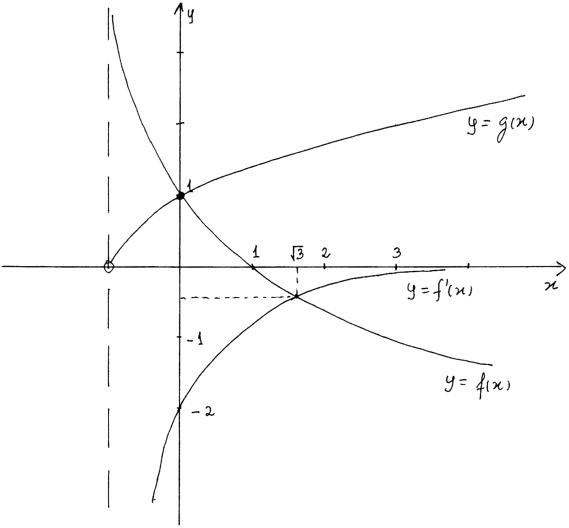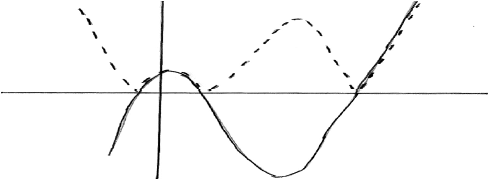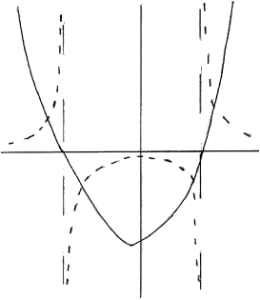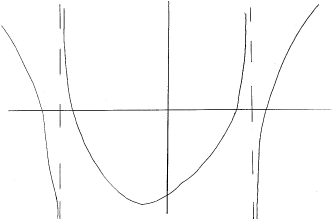Question
Find the set of values of x for which \(\left| {0.1{x^2} – 2x + 3} \right| < {\log _{10}}x\) .
Answer/Explanation
Markscheme
Attempting to solve \(\left| {0.1{x^2} – 2x + 3} \right| = {\log _{10}}x\) numerically or graphically. (M1)
x = 1.52, 1.79 (A1)(A1)
x = 17.6, 19.1 (A1)
\((1.52 < x < 1.79) \cup (17.6 < x < 19.1)\) A1A1 N2
[6 marks]
Examiners report
This question was generally not well done. A number of candidates attempted an ‘ill-fated’ algebraic approach. Most candidates who used their GDC were able to correctly locate one inequality. The few successful candidates were able to employ a suitable window or suitable window(s) to correctly locate both inequalities.
Question
Let \(f(x) = \frac{{1 – x}}{{1 + x}}\) and \(g(x) = \sqrt {x + 1} \), \(x > – 1\).
Find the set of values of \(x\) for which \(f'(x) \leqslant f(x) \leqslant g(x)\) .
Answer/Explanation
Markscheme

\(f'(x) = \frac{{ – 2}}{{{{\left( {1 + x} \right)}^2}}}\) M1A1
Note: Alternatively, award M1A1 for correct sketch of the derivative.
find at least one point of intersection of graphs (M1)
\(y = f(x)\) and \(y = f'(x)\) for \(x = \sqrt 3 \) or \(1.73\) (A1)
\(y = f(x)\) and \(y = g(x)\) for \(x = 0\) (A1)
forming inequality \(0 \leqslant x \leqslant \sqrt 3 \) (or \(0 \leqslant x \leqslant 1.73\)) A1A1 N4
Note: Award A1 for correct limits and A1 for correct inequalities.
[7 marks]
Examiners report
Most students were able to find the derived function correctly, although attempts to solve the inequality algebraically were often unsuccessful. This was a question where students prepared in good use of GDC were able to easily obtain good marks.
Question
The sum of the first 16 terms of an arithmetic sequence is 212 and the fifth term is 8.
Find the first term and the common difference.
Find the smallest value of n such that the sum of the first n terms is greater than 600.
Answer/Explanation
Markscheme
\({S_n} = \frac{n}{2}[2a + (n – 1)d]\)
\(212 = \frac{{16}}{2}(2a + 15d)\,\,\,\,\,( = 16a + 120d)\) A1
\({n^{th}}{\text{ term is }}a + (n – 1)d\)
\(8 = a + 4d\) A1
solving simultaneously: (M1)
\(d = 1.5,{\text{ }}a = 2\) A1
[4 marks]
\(\frac{n}{2}[4 + 1.5(n – 1)] > 600\) (M1)
\( \Rightarrow 3{n^2} + 5n – 2400 > 0\) (A1)
\( \Rightarrow n > 27.4…,{\text{ }}(n < – 29.1…)\)
Note: Do not penalize improper use of inequalities.
\( \Rightarrow n = 28\) A1
[3 marks]
Examiners report
This proved to be a good start to the paper for most candidates. The vast majority made a meaningful attempt at this question with many gaining the correct answers. Candidates who lost marks usually did so because of mistakes in the working. In part (b) the most efficient way of gaining the answer was to use the calculator once the initial inequality was set up. A small number of candidates spent valuable time unnecessarily manipulating the algebra before moving to the calculator.
This proved to be a good start to the paper for most candidates. The vast majority made a meaningful attempt at this question with many gaining the correct answers. Candidates who lost marks usually did so because of mistakes in the working. In part (b) the most efficient way of gaining the answer was to use the calculator once the initial inequality was set up. A small number of candidates spent valuable time unnecessarily manipulating the algebra before moving to the calculator.
Question
The arithmetic sequence \(\{ {u_n}:n \in {\mathbb{Z}^ + }\} \) has first term \({u_1} = 1.6\) and common difference d = 1.5. The geometric sequence \(\{ {v_n}:n \in {\mathbb{Z}^ + }\} \) has first term \({v_1} = 3\) and common ratio r = 1.2.
Find an expression for \({u_n} – {v_n}\) in terms of n.
Determine the set of values of n for which \({u_n} > {v_n}\).
Determine the greatest value of \({u_n} – {v_n}\). Give your answer correct to four significant figures.
Answer/Explanation
Markscheme
\({u_n} – {v_n} = 1.6 + (n – 1) \times 1.5 – 3 \times {1.2^{n – 1}}{\text{ }}( = 1.5n + 0.1 – 3 \times {1.2^{n – 1}})\) A1A1
[2 marks]
attempting to solve \({u_n} > {v_n}\) numerically or graphically. (M1)
\(n = 2.621 \ldots ,9.695 \ldots \) (A1)
So \(3 \leqslant n \leqslant 9\) A1
[3 marks]
The greatest value of \({u_n} – {v_n}\) is 1.642. A1
Note: Do not accept 1.64.
[1 mark]
Examiners report
In part (a), most candidates were able to express \({u_n}\) and \({v_n}\) correctly and hence obtain a correct expression for \({u_n} – {v_n}\). Some candidates made careless algebraic errors when unnecessarily simplifying \({u_n}\) while other candidates incorrectly stated \({v_n}\) as \(3{(1.2)^n}\).
In parts (b) and (c), most candidates treated n as a continuous variable rather than as a discrete variable. Candidates should be aware that a GDC’s table feature can be extremely useful when attempting such question types.
In parts (b) and (c), most candidates treated n as a continuous variable rather than as a discrete variable. Candidates should be aware that a GDC’s table feature can be extremely useful when attempting such question types. In part (c), a number of candidates attempted to find the maximum value of n rather than attempting to find the maximum value of \({u_n} – {v_n}\).
Question
The arithmetic sequence \(\{ {u_n}:n \in {\mathbb{Z}^ + }\} \) has first term \({u_1} = 1.6\) and common difference d = 1.5. The geometric sequence \(\{ {v_n}:n \in {\mathbb{Z}^ + }\} \) has first term \({v_1} = 3\) and common ratio r = 1.2.
Find an expression for \({u_n} – {v_n}\) in terms of n.
Determine the set of values of n for which \({u_n} > {v_n}\).
Determine the greatest value of \({u_n} – {v_n}\). Give your answer correct to four significant figures.
Answer/Explanation
Markscheme
\({u_n} – {v_n} = 1.6 + (n – 1) \times 1.5 – 3 \times {1.2^{n – 1}}{\text{ }}( = 1.5n + 0.1 – 3 \times {1.2^{n – 1}})\) A1A1
[2 marks]
attempting to solve \({u_n} > {v_n}\) numerically or graphically. (M1)
\(n = 2.621 \ldots ,9.695 \ldots \) (A1)
So \(3 \leqslant n \leqslant 9\) A1
[3 marks]
The greatest value of \({u_n} – {v_n}\) is 1.642. A1
Note: Do not accept 1.64.
[1 mark]
Examiners report
In part (a), most candidates were able to express \({u_n}\) and \({v_n}\) correctly and hence obtain a correct expression for \({u_n} – {v_n}\). Some candidates made careless algebraic errors when unnecessarily simplifying \({u_n}\) while other candidates incorrectly stated \({v_n}\) as \(3{(1.2)^n}\).
In parts (b) and (c), most candidates treated n as a continuous variable rather than as a discrete variable. Candidates should be aware that a GDC’s table feature can be extremely useful when attempting such question types.
In parts (b) and (c), most candidates treated n as a continuous variable rather than as a discrete variable. Candidates should be aware that a GDC’s table feature can be extremely useful when attempting such question types. In part (c), a number of candidates attempted to find the maximum value of n rather than attempting to find the maximum value of \({u_n} – {v_n}\).
Question
The seventh, third and first terms of an arithmetic sequence form the first three terms of a geometric sequence.
The arithmetic sequence has first term \(a\) and non-zero common difference \(d\).
Show that \(d = \frac{a}{2}\).
The seventh term of the arithmetic sequence is \(3\). The sum of the first \(n\) terms in the arithmetic sequence exceeds the sum of the first \(n\) terms in the geometric sequence by at least \(200\).
Find the least value of \(n\) for which this occurs.
Answer/Explanation
Markscheme
using \(r = \frac{{{u_2}}}{{{u_1}}} = \frac{{{u_3}}}{{{u_2}}}\) to form \(\frac{{a + 2d}}{{a + 6d}} = \frac{a}{{a + 2d}}\) (M1)
\(a(a + 6d) = {(a + 2d)^2}\) A1
\(2d(2d – a) = 0\;\;\;\)(or equivalent) A1
since \(d \ne 0 \Rightarrow d = \frac{a}{2}\) AG
[3 marks]
substituting \(d = \frac{a}{2}\) into \(a + 6d = 3\) and solving for \(a\) and \(d\) (M1)
\(a = \frac{3}{4}\) and \(d = \frac{3}{8}\) (A1)
\(r = \frac{1}{2}\) A1
\(\frac{n}{2}\left( {2 \times \frac{3}{4} + (n – 1)\frac{3}{8}} \right) – \frac{{3\left( {1 – {{\left( {\frac{1}{2}} \right)}^n}} \right)}}{{1 – \frac{1}{2}}} \ge 200\) (A1)
attempting to solve for \(n\) (M1)
\(n \ge 31.68 \ldots \)
so the least value of \(n\) is 32 A1
[6 marks]
Total [9 marks]
Examiners report
Part (a) was reasonably well done. A number of candidates used \(r = \frac{{{u_1}}}{{{u_2}}} = \frac{{{u_2}}}{{{u_3}}}\) rather than \(r = \frac{{{u_2}}}{{{u_1}}} = \frac{{{u_3}}}{{{u_2}}}\). This invariably led to candidates obtaining \(r = 2\) in part (b).
In part (b), most candidates were able to correctly find the first term and the common difference for the arithmetic sequence. However a number of candidates either obtained \(r = 2\) via means described in part (a) or confused the two sequences and used \({u_1} = \frac{3}{4}\) for the geometric sequence.
Question
Compactness is a measure of how compact an enclosed region is.
The compactness, \(C\) , of an enclosed region can be defined by \(C = \frac{{4A}}{{\pi {d^2}}}\), where \(A\) is the area of the region and \(d\) is the maximum distance between any two points in the region.
For a circular region, \(C = 1\).
Consider a regular polygon of \(n\) sides constructed such that its vertices lie on the circumference of a circle of diameter \(x\) units.
If \(n > 2\) and even, show that \(C = \frac{n}{{2\pi }}\sin \frac{{2\pi }}{n}\).
If \(n > 1\) and odd, it can be shown that \(C = \frac{{n\sin \frac{{2\pi }}{n}}}{{\pi \left( {1 + \cos \frac{\pi }{n}} \right)}}\).
Find the regular polygon with the least number of sides for which the compactness is more than \(0.99\).
If \(n > 1\) and odd, it can be shown that \(C = \frac{{n\sin \frac{{2\pi }}{n}}}{{\pi \left( {1 + \cos \frac{\pi }{n}} \right)}}\).
Comment briefly on whether C is a good measure of compactness.
Answer/Explanation
Markscheme
each triangle has area \(\frac{1}{8}{x^2}\sin \frac{{2\pi }}{n}\;\;\;({\text{use of }}\frac{1}{2}ab\sin C)\) (M1)
there are \(n\) triangles so \(A = \frac{1}{8}n{x^2}\sin \frac{{2\pi }}{n}\) A1
\(C = \frac{{4\left( {\frac{1}{8}n{x^2}\sin \frac{{2\pi }}{n}} \right)}}{{\pi {n^2}}}\) A1
so \(C = \frac{n}{{2\pi }}\sin \frac{{2\pi }}{n}\) AG
[3 marks]
attempting to find the least value of \(n\) such that \(\frac{n}{{2\pi }}\sin \frac{{2\pi }}{n} > 0.99\) (M1)
\(n = 26\) A1
attempting to find the least value of \(n\) such that \(\frac{{n\sin \frac{{2\pi }}{n}}}{{\pi \left( {1 + \cos \frac{\pi }{n}} \right)}} > 0.99\) (M1)
\(n = 21\) (and so a regular polygon with 21 sides) A1
Note: Award (M0)A0(M1)A1 if \(\frac{n}{{2\pi }}\sin \frac{{2\pi }}{n} > 0.99\) is not considered and \(\frac{{n\sin \frac{{2\pi }}{n}}}{{\pi \left( {1 + \cos \frac{\pi }{n}} \right)}} > 0.99\) is correctly considered.
Award (M1)A1(M0)A0 for \(n = 26\).
[4 marks]
EITHER
for even and odd values of n, the value of C seems to increase towards the limiting value of the circle \((C = 1)\) ie as n increases, the polygonal regions get closer and closer to the enclosing circular region R1
OR
the differences between the odd and even values of n illustrate that this measure of compactness is not a good one. R1
Question
A function \(f\) is defined by \(f(x) = (x + 1)(x-1)(x-5),{\text{ }}x \in \mathbb{R}\).
Find the values of \(x\) for which \(f(x) < \left| {f(x)} \right|\).
A function \(g\) is defined by \(g(x) = {x^2} + x – 6,{\text{ }}x \in \mathbb{R}\).
Find the values of \(x\) for which \(g(x) < \frac{1}{{g(x)}}\).
Answer/Explanation
Markscheme

as roots of \(f(x) = 0\) are \( – 1,{\text{ }}1,{\text{ }}5\) (M1)
solution is \(\left] { – \infty ,{\text{ }} – 1} \right[ \cup \left] {1,{\text{ }}5} \right[\;\;\;(x < – 1\;\;\;{\text{or}}\;\;\;1 < x < 5)\) A1A1
Note: Award A1A0 for closed intervals.
[3 marks]
METHOD 1
\(\left( {{\text{graphs of }}g(x){\text{ and }}\frac{1}{{g(x)}}} \right)\)

roots of \(g(x) = 0\) are \( – 3\) and 2 (M1)(A1)
Notes: Award M1 if quadratic graph is drawn or two roots obtained.
Roots may be indicated anywhere eg asymptotes on graph or in inequalities below.
the intersections of the graphs \(g(x)\) and of \(1/g(x)\)
are \( – 3.19,{\text{ }} – 2.79,{\text{ }}1.79,{\text{ 2.19}}\) (M1)(A1)
Note: Award A1 for at least one of the values above seen anywhere.
solution is \(\left] { – 3.19,{\text{ }} – 3} \right[ \cup \left] { – 2.79,{\text{ }}1.79} \right[ \cup \left] {2,{\text{ }}2.19} \right[\)
\(( – 3.19 < x < – 3\;\;\;{\text{or}}\;\;\; – 2.79 < x < 1.79\;\;\;{\text{or}}\;\;\;2 < x < 2.19)\) A1A1A1
Note: Award A1A1A0 for closed intervals.
METHOD 2
\(\left( {{\text{graph of }}g(x) – \frac{1}{{g(x)}}} \right)\)

asymptotes at \(x = – 3\) and \(x = 2\) (M1)(A1)
Note: May be indicated on the graph.
roots of graph are \( – 3.19,{\text{ }} – 2.79,{\text{ }}1.79,{\text{ }}2.19\) (M1)(A1)
Note: Award A1 for at least one of the values above seen anywhere.
solution is (when graph is negative)
\(\left] { – 3.19,{\text{ }} – 3} \right[ \cup \left] { – 2.79,{\text{ }}1.79} \right[ \cup \left] {2,{\text{ }}2.19} \right[\)
\(( – 3.19 < x < – 3\;\;\;{\text{or}}\;\;\; – 2.79 < x < 1.79\;\;\;{\text{or}}\;\;\;2 < x < 2.19)\) A1A1A1
Note: Award A1A1A0 for closed intervals.
[7 marks]
Total [10 marks]
Examiners report
In general part (a) was performed correctly, with the vast majority of candidates stating the correct open intervals as required.
In part (b) many candidates scored a few marks by just finding intersection points and equations of asymptotes; many other candidates showed difficulties in manipulating inequalities and ignored the fact that the quantities could be negative. Candidates that used the graph well managed to achieve full marks. Unfortunately many sketches were very crudely drawn hence they were of limited value for assessment purposes.
